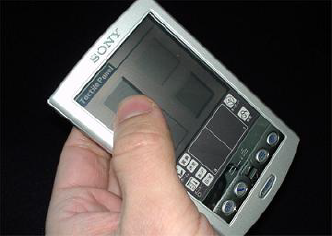Former Project on Creativity
TouchEngine
クリック感を再現するヒューマンインターフェースモジュール
現在広く普及しているタッチパネルは、メカニカルなスイッチと比べて、操作を行なった感覚=フィードバックがないことが最大の欠点となっています。 TouchEngine は、圧電素子を用いてタッチパネルを振動させることで、フィードバックの触覚を再現しました。
自然なクリック感、複数の触覚パターンの再現も可能
 タッチパネルの入力に対してフィードバックを返す方法としては、入力に連動して振動モーターを回したり、メカニカルなスイッチでフィードバックを返すなどの方法が考えられてきました。 しかし、振動モーターなどによるフィードバックは、指先だけでなく、機器を持っている手にも振動が伝わることや、フィードバックが遅れることで、クリック感とは異なる違和感が生じます。 TouchEngine はタッチパネルだけを振動させることと、圧電素子の高い応答性を利用したシャープな反応を作り出すことで、自然なクリック感を再現しました。 圧電素子の構造を多層化することで、モバイル機器に適した低電圧駆動を実現し、複数の触覚パターンの再現が可能となっています。
タッチパネルの入力に対してフィードバックを返す方法としては、入力に連動して振動モーターを回したり、メカニカルなスイッチでフィードバックを返すなどの方法が考えられてきました。 しかし、振動モーターなどによるフィードバックは、指先だけでなく、機器を持っている手にも振動が伝わることや、フィードバックが遅れることで、クリック感とは異なる違和感が生じます。 TouchEngine はタッチパネルだけを振動させることと、圧電素子の高い応答性を利用したシャープな反応を作り出すことで、自然なクリック感を再現しました。 圧電素子の構造を多層化することで、モバイル機器に適した低電圧駆動を実現し、複数の触覚パターンの再現が可能となっています。
TouchEngine はニューヨーク ソニー・ワンダーテクノロジーラボで2009年から展示されています。